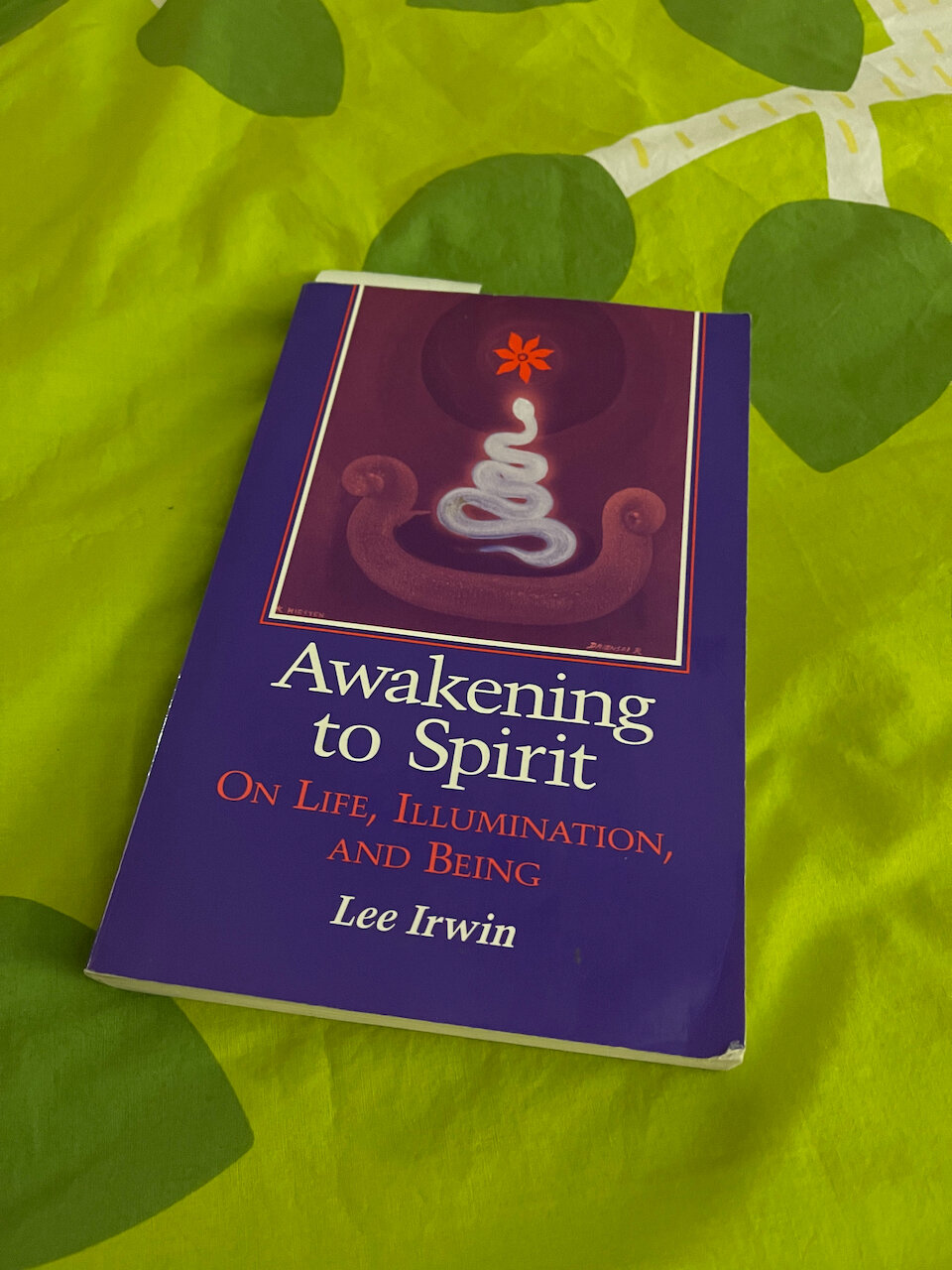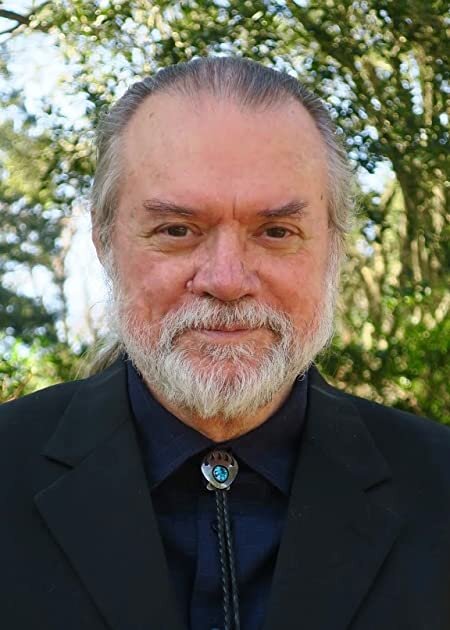Awakening to Spirit.
Going beyond ourselves
I love used book shops. My days of walking out with 5-10 books to take home and read are over, but I did find a gem at the Wee Book Inn on Whyte Avenue (in Edmonton). Awakening to Spirit: On Life, Illumination, and Being (1999) was written by Lee Irwin, who teaches religious studies at the College of Charleston in Berea, Kentucky. Irwin’s research interests include Native American spirituality, western esotericism, eastern religions, transpersonal theory, and parapsychological research.
I had never heard of the book or Lee Irwin when I discovered it, but Irwin’s ability to bring so many spiritual traditions together so seamlessly caught my attention as I flipped through his work. Irwin notes in the book that he has done a lot of study, writing, meditation, dreaming, and vision-seeking in a “diversity of spiritual communities,” and his writing reflects that diversity.
A few days after I bought the book, I started to make a connection between Awakening to Spirit and my website, Some Kind of Fight. It was Irwin himself who helped me make the connection. I asked him how he felt about his book more than 20 years after its publication. His response: “I think Awakening is just as relevant for me today as it was when I wrote it. The issues have a strong transpersonal theme, so I was writing for the present and future.”
The term “transpersonal” is the key. The simplest definition of transpersonal is “beyond the personal or individual.” In pyschology and spirituality, it means reaching states of consciousness beyond the limits of our personal identity, going beyond ourselves, etc. Tim Read, co-editor of Psychedelics & Psychotherapy: The Healing Potential of Expanded States, says the transpersonal transcends our sense of who we think we are:
We may identify with another person, an animal, a plant, a life lived in a different period in history or even in a different universe. We may experience a succession of deaths or visit periods before birth or after death. We may perceive that the cosmos is essentially composed of love, or we may have a numinous experience of union with the Divine.
We see a bigger picture; a larger framework is revealed. The universe is larger than we thought and our identity is smaller than we thought, yet we are not insignificant or irrelevant. We have a new understanding of our place in the scheme of things.
Irwin’s book offers ten principles that express a transpersonal state of consciousness. The formulation of these principles was itself a transpersonal experience for Irwin. He writes that that ten principles came to him in “a single spontaneous burst of inspiration, not sought at the time, but flowing forth with an intensity and momentary clarity of mind, heart, and intent that was truly memorable and transformative.”
From Awakening to Spirit … Ten Principles
The First Principle of Spirit is the gift of life; this means that the experience of being alive, having life, is a primary manifestation of Divine Mystery. (1.1)
The Second Principle of Spirit is that every manifestation of life has its own unique awareness, a being that constitutes its form; there is no life without such awareness. (2.1)
The Third Principle of Spirit is understanding: this means being able to sense, feel, intuit, and empathize with every living thing; analysis and reason without understanding is both dangerous and destructive. (3.1)
The Fourth Principle of Spirit is its unknowable immensity; this is not first because only after life, awareness, and understanding is knowledge possible, a knowledge of the hidden foundations, the Mystery. (4.1)
The Fifth Principle of Spirit is compassionate love—sensual, emotional, intellectual, aesthetic, and spiritual—it gives itself to others, it receives them without shame. (5.1)
The Sixth Principle of Spirit is the manifestation of wisdom and illumination; from the illumination of the heart to the illumination of body, mind, and will. (6.1)
The Seventh Principle of Spirit is ecstasy, the union of individual life with the eternal, with the ultimate source of renewal and transformation, with the unextinguished Light. (7.1)
The Eighth Principle of Spirit is freedom from constraint; the wild grasses of the field know nothing of the plow, their seeds are scattered by the winds, not by human hands. (8.1)
The Ninth Principle of Spirit is peace, nonviolence, and creative joy; the birth of new worlds, the opening of horizons free of fear, uncontaminated by possessive lust, lies, or confusion. (9.1)
The Tenth Principle of Spirit is solitude, calm, and repose; everything grows old, matures, deepens, and acquires the luster of age, this is natural and good every death, a new beginning. (10.1)
Altered states of consciousness
Transpersonal experiences make it possible to understand and enjoy our profound connectedness to others, and can transform romantic/sexual relationships. Transpersonal therapy and/or transpersonal spiritual practices are a gateway to these experiences, and altered states of consciousness (ASCs) are one of the most interesting and effective ways to access the transpersonal.
ASCs allow us to leave our ordinary state of consciousness and the maladapted patterns that might be ingrained in it, and open us to the possibility of new patterns of thought, feeling, and behaviour. Tim Read says “Our concerns may be radically changed by new perspectives: our creative instincts are renewed, and we may gain insights into the essential nature of things.”
In the shamanic traditions, ASCs facilitate a “journey” in which one travels to some other realm to acquire new perceptions and insights, returning changed in some constructive manner. In the Christian tradition, the conversion experience, prayer, and the experience of being filled with the Spirit are ASCs in which individuals achieve a profound change in thinking, feeling, and perception. Mysticism is another part of the Christian tradition that focuses on ASCs, in which a contemplative encounter with God elevates consciousness and transforms the practitioner. In meditation, ASCs provide opportunity to observe thoughts and feelings without judgment. Calming meditation involves focusing on a particular object—breath, a mantra, a visualization, a physical object, even physical sensations within the body—and returning to that object whenever one is distracted or notices the mind starting to wander. By not focusing on anxiety, pain, etc., the practitioner realizes their pathology is not inherent to their truest self. Insight meditation involves being aware of and noting all the physical and mental sensations that arise, gradually developing the ability to accept, push through, and overcome one’s pathology. Guided imagery is a therapeutic and spiritual approach to ASCs, in which individuals are led on a journey through their fantasies, dreams, memories, and other products of the imagination to uncover and resolve difficulties. Some guided imagery therapists use hypnotic regression to do what is commonly called past life therapy, in which patients explore connections between present-day conflicts and experiences from previous lives (metaphorical or literal), providing insights that relate to current, ongoing challenges in their life.
People who experience ASCs typically report significant and lasting benefits, though there’s a caution. Transpersonal experiences diminish our ego-identity, and this can be constructive or destructive. The outcome depends on the way our ego-identity becomes porous or open. When our ego-identity becomes porous/open through transpersonal therapies and spiritual practices, our identity typically expands and we achieve a sense of greater connectedness of ourselves to everything else. When our ego-identity becomes porous/open through illness, trauma, drugs/alcohol, or impaired personal growth and development, our identity disintegrates, which makes it difficult to connect anything in ourselves to anyone or anything else. This is a bit of a catch-22: transpersonal therapy/spiritual experiences can help us overcome illness, trauma, substance abuse, etc. but these pathologies may have disintegrated our ego-identity to an extent that limits the potential of transpersonal work. Consulting with therapists, doctors, spiritual leaders, etc., and paying close attention to our wellbeing can help us move past this roadblock.
Transpersonal recovery from trauma
Gabor Maté is one of many therapists exploring the role of transpersonal experiences in recovery. (His work includes a focus on psychedelic-induced transpersonal experiences.) For Maté, the term recovery is significant:
In addictions we use the word recovery, which means finding something that you have lost. Whatever you find couldn’t have been destroyed, and it must have been there all along otherwise you couldn’t have found it. What people recover when they recover from addictions is themselves.
Maté focuses on trauma as a cause of addiction, and defines it not as an external event that happens to us but the impact of the event; specifically, “the lost connection to yourself.” We are traumatized because our experiences resulted in losing connection with ourselves, and we lost connection with ourselves in order to avoid pain:
If it is so painful to be myself, I better disconnect. If it is so painful for me to be aware of my gut feelings and to be able to assert, manifest, and declare them, I better disconnect. And then we spend the rest of our lives trying to compensate for this disconnection through addiction or by developing certain personality patterns that will somehow get us indirectly what we didn’t get in the first place: the love that would have allowed us to connect to ourselves.
Focusing on psychedelic therapy, Maté believes ASCs can allow us to re-experience the inner qualities we lost connection to. We quite literally remember ourselves.
ASCs and relationships
The ASCs provided by transpersonal therapies and transpersonal spiritual experiences are part of the “fight”—the struggle/growth process that allows us to transcend our ego-centric way of being and connect to another person (and the universe) in ways that are more uninhibited and free-flowing and less anxious or traumatic. We resolve our fears, open up to Love, enter into another person’s life, and welcome that person into ours more fully and completely … without losing ourselves.
Perhaps the real work for those of us who experience ASCs is how to integrate the breakthroughs ASCs provide into our ordinary life, including our relationships. Faith is key here. Not faith as in dogma, doctrine, etc., but faith as in trust. We need to trust that the “unknowable immensity,” “compassionate love,” “ecstasy,” “the union of individual life with the eternal,” “freedom from constraint,” “creative joy,” etc. we experience in ASCs is the “real” real, and that the fear, anxiety, self-doubt, self isolation, etc. we feel in so-called real life is an illusion. When we believe what we experience in ASCs is really real, it can re-energize our relationship with ourselves and with others.
Note: some of the material in this post is derived from the following sources:
Mark C. Kasprow, M.D. and Bruce W. Scotton, M.D., “A Review of Transpersonal Theory and Its Application to the Practice of Psychotherapy.”
Tim Read and & Maria Papaspyrou (eds.), Psychedelics & Psychotherapy: The Healing Potential of Expanded States.
Lee Irwin, Awakening to Spirit: On Life, Illumination, and Being.




